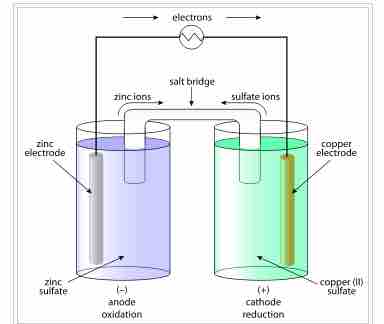An electrochemical cell is a device that produces an electric current from energy released by a spontaneous redox reaction. This kind of cell includes the galvanic, or voltaic, cell, named after Luigi Galvani and Alessandro Volta. These scientists conducted several experiments on chemical reactions and electric current during the late 18th century.
Electrochemical cells have two conductive electrodes, called the anode and the cathode. The anode is defined as the electrode where oxidation occurs. The cathode is the electrode where reduction takes place. Electrodes can be made from any sufficiently conductive materials, such as metals, semiconductors, graphite, and even conductive polymers. In between these electrodes is the electrolyte, which contains ions that can freely move.
The voltaic cell uses two different metal electrodes, each in an electrolyte solution. The anode will undergo oxidation and the cathode will undergo reduction. The metal of the anode will oxidize, going from an oxidation state of 0 (in the solid form) to a positive oxidation state, and it will become an ion. At the cathode, the metal ion in the solution will accept one or more electrons from the cathode, and the ion's oxidation state will reduce to 0. This forms a solid metal that deposits on the cathode. The two electrodes must be electrically connected to each other, allowing for a flow of electrons that leave the metal of the anode and flow through this connection to the ions at the surface of the cathode. This flow of electrons is an electrical current that can be used to do work, such as turn a motor or power a light.
Example Reaction
The operating principle of the voltaic cell is a simultaneous oxidation and reduction reaction, called a redox reaction. This redox reaction consists of two half-reactions. In a typical voltaic cell, the redox pair is copper and zinc, represented in the following half-cell reactions:
Zinc electrode (anode): Zn(s) → Zn2+(aq) + 2 e–
Copper electrode (cathode): Cu2+(aq) + 2 e– → Cu(s)
The cells are constructed in separate beakers. The metal electrodes are immersed in electrolyte solutions. Each half-cell is connected by a salt bridge, which allows for the free transport of ionic species between the two cells. When the circuit is complete, the current flows and the cell "produces" electrical energy.

A galvanic, or voltaic, cell
The cell consists of two half-cells connected via a salt bridge or permeable membrane. The electrodes are immersed in electrolyte solutions and connected through an electrical load.
Copper readily oxidizes zinc; the anode is zinc and the cathode is copper. The anions in the solutions are sulfates of the respective metals. When an electrically conducting device connects the electrodes, the electrochemical reaction is:
Zn + Cu2+ → Zn2+ + Cu
The zinc electrode produces two electrons as it is oxidized (
Voltaic cells are typically used as a source of electrical power. By their nature, they produce direct current. A battery is a set of voltaic cells that are connected in parallel. For instance, a lead–acid battery has cells with the anodes composed of lead and cathodes composed of lead dioxide.